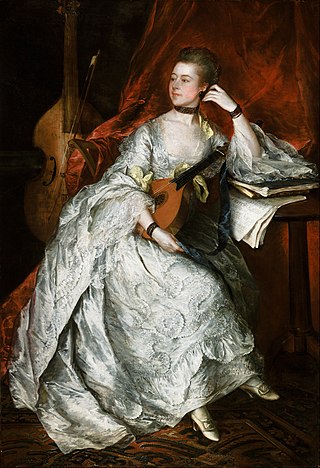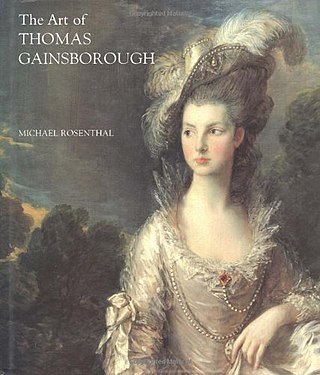
Thomas Gainsborough was an English portrait and landscape painter, draughtsman, and printmaker. Along with his rival Sir Joshua Reynolds, he is considered one of the most important British artists of the second half of the 18th century. He painted quickly, and the works of his maturity are characterised by a light palette and easy strokes. Despite being a prolific portrait painter, Gainsborough gained greater satisfaction from his landscapes. He is credited as the originator of the 18th-century British landscape school. Gainsborough was a founding member of the Royal Academy.

Vladimir Lukich Borovikovsky was a prominent Russian Imperial artist of Ukrainian Cossack background, who served at the court of Catherine the Great and dominated portraiture in the Russian Empire at the turn of the 19th century.

Captain Philip Thicknesse was an English author, eccentric, and friend of the artist Thomas Gainsborough. He wrote several travel guides.

Mr and Mrs Andrews is an oil on canvas portrait of about 1750 by Thomas Gainsborough, now in the National Gallery, London. Today it is one of his most famous works, but it remained in the family of the sitters until 1960 and was very little known before it appeared in an exhibition in Ipswich in 1927, after which it was regularly requested for other exhibitions in Britain and abroad, and praised by critics for its charm and freshness. By the post-war years its iconic status was established, and it was one of four paintings chosen to represent British art in an exhibition in Paris celebrating the Coronation of Queen Elizabeth II in 1953. Soon the painting began to receive hostile scrutiny as a paradigm of the paternalist and capitalist society of 18th-century England, but it remains a firm popular favourite.
Vincent van Gogh lived during the Impressionist era. With the development of photography, painters and artists turned to conveying the feeling and ideas behind people, places, and things rather than trying to imitate their physical forms. Impressionist artists did this by emphasizing certain hues, using vigorous brushstrokes, and paying attention to highlighting. Vincent van Gogh implemented this ideology to pursue his goal of depicting his own feelings toward and involvement with his subjects. Van Gogh's portraiture focuses on color and brushstrokes to demonstrate their inner qualities and Van Gogh's own relationship with them.

Arthur Devis was an English artist whose father, Anthony, was progenitor of what became a family dynasty of painters and writers. The place of Arthur Devis in art history is generally as painter of the type of portrait now called a conversation piece. After moving to London and apprenticeship to a Flemish topographical artist there, he switched to portraiture and acquired a considerable reputation, although this success did not last. Unable to adapt to later fashionable artistic currents, his commissions declined and his work was largely forgotten after his death until the 20th century revival of interest in the conversation piece.

Fancy pictures are a sub-genre of genre paintings in 18th-century English art, featuring scenes of everyday life but with an imaginative or storytelling element, usually sentimental. The usage of the term varied, and there was often an overlap with the conversation piece, a type of group portrait showing the subjects engaged in some activity.

The Harvest Wagon is the name of two oil paintings by the English artist Thomas Gainsborough. The first version was completed around 1767 and is today owned by the Barber Institute of Fine Arts, in Birmingham, England. The second version was painted around 1784 and is now part of the collection of the Art Gallery of Ontario. The Toronto version is the better known of the two. It was donated to the AGO by Frank P Wood in 1941, and is one of the most prominent pieces in the gallery’s collection.

Cottages is a subject of paintings created by Vincent van Gogh from 1883 and 1885. This is related to the Peasant Character Studies that Van Gogh worked on during the same time period.

Thomas Barker or Barker of Bath, was a British painter of landscape and rural life.

Vincent van Gogh enjoyed making Paintings of Children. He once said that it's the only thing that "excites me to the depths of my soul, and which makes me feel the infinite more than anything else." Painting children, in particular represented rebirth and the infinite. Over his career Van Gogh did not make many paintings of children, but those he completed were special to him. During the ten years of Van Gogh's career as a painter, from 1881 to 1890, his work changed and grew richer, particularly in how he used color and techniques symbolically or evocatively.

Peasant Character Studies is a series of works that Vincent van Gogh made between 1881 and 1885.

Gainsborough Dupont was a British artist, the nephew and pupil of Thomas Gainsborough, R.A.

Mrs. Richard Brinsley Sheridan (1787) is an oil on canvas portrait painted by Thomas Gainsborough between 1785 and 1787. It was acquired by the National Gallery of Art in 1937. Mrs. Sheridan was a talented musician who enjoyed professional success in Bath and London before marrying Richard Brinsley Sheridan in 1773 and abandoning her career. She was 31-33 when she sat for Gainsborough, dying from tuberculosis seven years later at the age of thirty-eight. The portrait was painted between 1785 and 1787, and, was exhibited at Gainsborough's studio at Schomberg House, Pall Mall in 1786.

Gainsborough's House is the birthplace of the leading English painter Thomas Gainsborough. It is now a museum and gallery, located at 46 Gainsborough Street in Sudbury, Suffolk, England. Some of the pictures on display have been acquired with the help of the Art Fund.

Michael J. Rosenthal is emeritus professor of the history of art at the University of Warwick. He is a specialist both in British art and culture of the eighteenth and early nineteenth centuries, and the arts of early colonial Australia.
Ann Cathleen Bermingham is an American art historian and educator. A specialist on eighteenth- and nineteenth-century British art, Bermingham is Professor of Art History Emeritus at the University of California, Santa Barbara.

Hugh Graham Belsey, MBE, is a British art historian who is an authority on the art of Thomas Gainsborough. For 23 years he was the curator of Gainsborough's House in Sudbury. His most recent contribution to Gainsborough scholarship is his catalogue raisonné of Gainsborough's portraits published in February 2019 by the Yale University Press for the Paul Mellon Centre for Studies in British Art.
Elizabeth Murray, born Elizabeth Heaphy, was a British watercolourist. She primarily painted portraits and landscapes of the Canary Islands, where she lived for ten years. She was a member of the Royal Institute of Painters in Water Colours, and she founded The Society of Female Artists in London.

Thomas Gainsborough was the first British artist to make a major study of the subject of gypsies, beginning with two paintings in the 1750s, the first of which he never finished, and the second of which is now lost, but survives in an etching by Gainsborough.


















